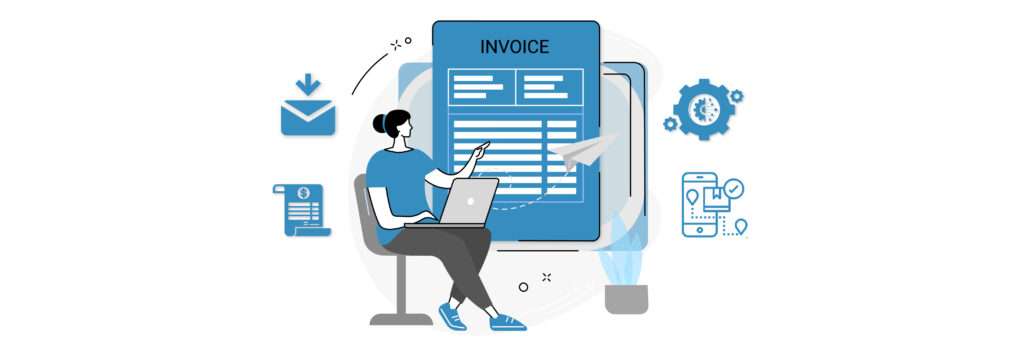Missed payments, duplicate invoices, and frustrated vendors are obvious signs something isn’t working in your AP organization. Historically, the solution has often been to hire more clerks which could be a killer for your AP productivity. But while it might help get invoices paid on time, this approach is costly and sometimes masks inefficiencies rather than resolving them.
According to a 2019 Payables Insights report from Levvel Research, 57% of organizations were still relying on manual AP processes. Inefficient, paper-first AP processes keep your existing team away from opportunities to learn new skills, take on additional responsibilities, and pave a path to advancement.
The consequences go beyond simply missing a few invoice payments; it can lead to falling behind in all other aspects as well.
The process you think you have
 A common invoice journey is described thus:
A common invoice journey is described thus:
1. An invoice arrives from a vendor via email or vendor portal
2. The AP specialist uploads it to their AP automation system
3. They code the invoice in that system
4. The invoice is sent through an approval workflow
5. The invoice is approved for payment
It sounds simple and direct enough. But steps are left out when they aren’t attached to a platform—or because they feel so obvious to someone doing the work daily, that they don’t bear articulating.
The process you actually have

1. An invoice arrives in the general AP email inbox
2. The AP specialist saves the invoice to a folder on her computer along with others from that same day
3. She opens each invoice and either uses another app to add a digital time stamp, or prints each invoice, physically stamps it, and then scans and uploads it back to her computer
4. The invoice is going to have some complex allocations, to get ahead of this, the AP specialist calls or emails a senior accountant or original purchaser to confirm the expected coding and allocations for the invoice
5. The accountant or purchaser consults a separate spreadsheet used to track information not stored in their system of record
6. They email additional information back to the AP specialist
7. The AP specialist has all the necessary information, she uploads the invoice to the system of record or AP automation system
8. The system captures the invoice image, but any data still must be manually entered into specific fields by the AP specialist
9. The AP specialist saves the invoice image and entered data as a new invoice record
10. Wait! The upload timed out, they must repeat the upload, and the data entry
11. The AP specialist completes invoice coding and allocation in the AP system according to information from the accountant, she reviews it one more time
12. She attaches the invoice to the appropriate approval workflow for review.
13. If everything is coded correctly, the invoice is approved for payment
Importance of Accounts Payable process for Increasing AP Productivity

In October’s second week, the Institute of Financial Operations honors AP Recognition Week, underscoring the importance of the accounts payable function. It is crucial to acknowledge the contributions of AP clerks, who ensure the accuracy of payment tracking, approval, and processing. Indeed, a business cannot thrive without effective AP processes, which are crucial to producing an accurate balance sheet.
The role of AP departments extends beyond these core functions. They also maintain positive relationships with suppliers by ensuring their information is current and processing payments promptly, fostering beneficial terms and discounts. Furthermore, accurate bookkeeping by AP departments enables precise cash forecasts and optimizes working capital. By preventing errors and fraud, AP departments help safeguard the financial integrity of the business.
Problem with manual data entry

If you observe any accounts payable (AP) department, particularly those operating on a larger scale and handling higher volumes of transactions, you are bound to come across at least one of the following issues. These problems can stem from human errors or inadequately defined processes, while others can be due to technical malfunctions. However, they all share one common trait – they adversely affect the department’s efficiency and productivity. When multiple issues pile up, it can significantly impede your business operations.
To enhance the performance of your AP department, consider the following seven areas of improvement.
1. Slow processing
Relying on paper-based processes in the accounts payable (AP) department can negatively impact productivity and accuracy. Invoices that pass through multiple desks increase the risk of errors and misplaced documents, resulting in significant delays in payment processing. Slow processing times can lead to late payments, damaging supplier relationships and potentially resulting in the loss of discounts or late payment fees.
2. Matching errors
Matching errors in the accounts payable (AP) department can occur due to discrepancies between purchase orders, invoices, and receiving reports. These mismatches require a manual investigation that can be time-consuming and often delays the processing of payments. Matching errors can have cascading effects, leading to slowdowns and additional delays in the department.
3. Exception invoices and manual follow-ups
In an ideal world, suppliers would submit 100% accurate invoices every time. However, in reality, mistakes, human errors, and inefficiencies can lead to incomplete or incorrect data, generating exceptions in your system. Addressing these exceptions can take days, requiring manual follow-ups with suppliers to obtain the necessary information and determine the next steps. These exceptions can lead to delays and potentially cause late payments. Moreover, conducting manual follow-ups can consume valuable time and resources that could be better utilized for other critical tasks.
4. Unauthorized purchases
The accounts payable (AP) process can face several challenges, including matching errors between purchase orders, invoices, and receiving reports, exceptions in invoices that require manual follow-ups, and unauthorized purchases. These issues can lead to delays, potentially causing late payments and negatively impacting supplier relationships.
5. Sending payment before delivery
While prompt payment can have benefits, premature payment can lead to several issues, particularly if the shipment is damaged or incomplete upon arrival. When AP teams operate in silos, with little communication between different departments, such issues can be even more difficult to resolve.
6. Lost invoices
Invoices may be misplaced or even accidentally destroyed, resulting in severe consequences. These include hefty late fees owed to vendors and complications in bookkeeping practices. When invoices go missing, it can be challenging to identify the root cause of the issue, making it difficult to prevent similar occurrences in the future.
7. Double payments
Various mistakes can cause your team to create multiple invoices for the same transaction. For instance, a typing error in a purchase order number could trigger two invoices instead of one. Human oversight, like forgetting to mark an invoice as already paid, may also result in duplicate billing. These issues with invoice processing can have considerable consequences for the company’s financial performance, as well as causing frustration for suppliers who have to refund you.
Uncovering and resolving AP bottlenecks for increased efficiency
Regardless of which issue is causing the most trouble, you’re likely noticing some common themes they all share:
▶ Poor visibility into the invoice life cycle
▶ Inherent inflexibility that blocks attempts to change
▶ Inability to scale that inhibits growth and strains employees
Overcoming siloed knowledge
| How they kill efficiency | How to fix them |
| Create painful bottlenecks and make systemic problems look like headcount problems— susceptible to turnover risk and adding more expense than efficiency. | Capture, codify, and centralize: every invoice coding decision follows pre-existing patterns, with the occasional exception. Patterns create predictability, which is essential for automation |
| Add to attrition by reinforcing manual and repetitive work rather than problem-solving and skill development. | You can use process templates to partially automate coding and reduce the number of decisions required for each batch of new invoices: this will require more up-front effort from your accounting and AP teams and might require custom development to build into your AP system. This approach is well-suited for fairly consistent coding practices and outsourcing AP work |
| Coding predictable invoices takes as long as managing exceptions because it’s not easily automated or delegated. | Select an AI-powered solution that can be trained to recognize patterns based on historical data, without being explicitly programmed or relying on templates. This approach will allow for the most flexibility over time, as well as a more rapid ramp-up time with adequate starting data and computing power. |
| Make training and onboarding difficult, and departures disruptive. | |
Overcoming offline detours
| How they kill efficiency | How to fix them |
| Going offline, or passing information through emails, disparate systems, spreadsheets, and on paper costs your visibility, making it hard to discern where the breakdown is happening. | Start with an honest, comprehensive audit focused not on tools but the broad discovery of hidden steps, workarounds, and how different people and teams adhere to ostensibly similar processes differently |
| Every back-and-forth exchange risks either losing something in translation or introducing accidental errors on top of delays. | Assume, and tell your team, that nothing is obvious, and no step is too insignificant to articulate. The Aha! moments regarding inefficiency will emerge from the stop-gap measures. |
| There is no insight for future audits—the invoices go into a black hole, and some re-emerge, but there’s no digital trail for what happened in the interim. | Your objective should be not to assign blame, but to identify what gaps are being compensated for and where and decide whether you need a better process or some tools to augment your existing tech stack. |
| These blind spots also make accurate reporting difficult, allowing useful operational data to evaporate without capture. | Review your process to understand which steps are adding value and which might be solving for an issue that is easily addressed with your existing toolkit. |
| If you haven’t, implement a single source of truth AP automation system to see each invoice throughout its life cycle. | |
Optimizing customized technology solutions
| How they kill efficiency | How to fix them |
| They’re inflexible by design and don’t adapt well to changing needs, which creates barriers to improvement over time. | Look outside your industry for best practices and tools growing in adoption. Sometimes a real estate-specific approach is critical. Many times, AP in other verticals can offer more streamlined tools and process examples |
| Can inadvertently force more offline approvals and workarounds, which hurts visibility and efficiency. | Optimize new systems for flexibility rather than hyper-specificity. Where does the extra tailoring actually add value? Is it saving time on decision-making by adding extra steps or up-front work? |
| Assumes unique process is a meaningful advantage without considering industry best practices. | Evaluate cloud-first software as a service (SaaS) solution with out-of-the-box functionality and faster time to value. Free your IT sources from worrying about hardware, installations, uptime, and upgrades |
| Lengthy implementation times added complexity and difficulty around updates, ongoing requirement of additional customization services. | Consider the trade-offs between specificity and the ability to operationalize. Is 100% functionality 12 months from now really better than 80% in a few weeks? |
Phasing out enduring legacy processes
| How they kill efficiency | How to fix them |
| Dis-empowers employees who are doing what they are told without being able to improve it. | Conduct an audit with fresh eyes. New hires or someone from outside your team or organization will have an easier time spotting what doesn’t make sense. |
| Enforce bad habits despite their cumulative cost over the long term. | Design for desired outcomes, not for adjusting to the tools and teams in place today. What would a process without any concessions look like? |
| Creates openings for offline workarounds and overly customized, inflexible solutions. | Understand what’s being solved with inefficient processes and assess which of those problems still need solving. |
| It is also not scalable, and relies on siloed knowledge, outdated methods, and paper and manual work. | Identify data gas and questions you can’t answer when designing a new process and know where you lose visibility. |
| Match hiring, training, and technology to the process you want. | |
Breaking free from the ERP ecosystem confinement
| How they kill efficiency | How to fix them |
| Over emphasizing integration doesn’t necessarily simplify and forces a balancing act between what’s working and what’s never going to be workable. | Choosing an ERP is like getting married migrating somewhere else can feel as painful and expensive as a divorce. But similarities end there. You don’t have to settle or practice platform monogamy. Choose best-in-class where it makes sense. |
| No control over whether something was designed as part of the ecosystem with the priority of fitting in or whether integrated through acquisition, and still not necessarily best, just what is connectible. | Push vendors who provide mission-critical software for APIs and collaboration to enable best-in-class solutions to address persistent pains |
| The vendor’s priority is to keep you around, not to do better or do everything exceptionally well. | When evaluating solutions, pay attention to what is fully productized, what is a platform that will demand custom implementation, and what is just a shiny new technology in search of a purpose or proof points. |
| Talk to your peers about whether implementation and total cost of ownership met expectations for recent tech investments to verify vendor claims. | |
Moving towards a fitter AP
“Invisible AP Inefficiency Tax” is the various ways in which inefficiency arises and drains time and resources. This goes beyond just the cost of late payment fees or the need to increase staff for data entry and paperwork processing. The cost also includes missed opportunities for work, skill development, and prioritizing business goals. The impact of persistent inefficiency varies in each organization, but it inevitably hinders growth, flexibility, profits, and operational capacity. In addition, it can harm vendor relationships, overwhelm teams, and damage credit ratings – this is not a new concept. However, the most damaging toll is often overlooked, which is the toll it takes on the AP team by keeping them stuck in tedious manual tasks




